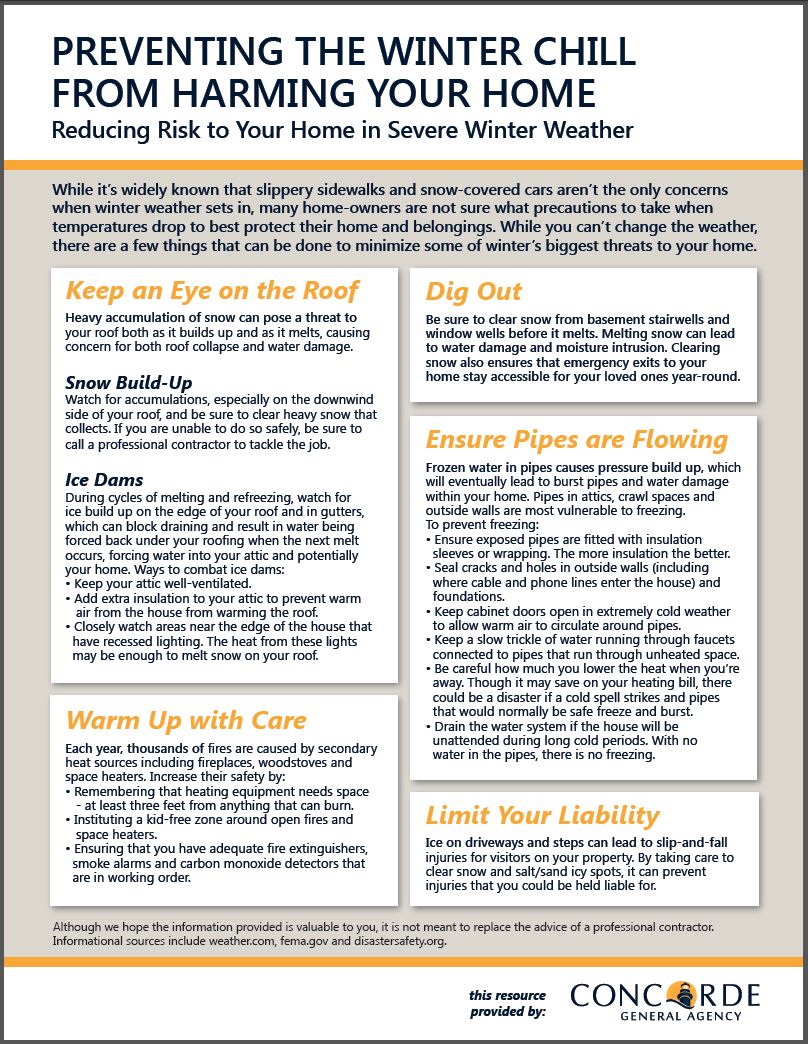Preventing the Winter Chill from Damaging Your Home (or Your Client's)
Reducing Risk to Your Home in Severe Winter Weather
 While it’s widely known that slippery sidewalks and snow-covered cars aren’t the only concerns when winter weather sets in, many home-owners are not sure what precautions to take when temperatures drop to best protect their home and belongings. While you can’t change the weather, there are a few things that can be done to minimize some of winter’s biggest threats to your home.
While it’s widely known that slippery sidewalks and snow-covered cars aren’t the only concerns when winter weather sets in, many home-owners are not sure what precautions to take when temperatures drop to best protect their home and belongings. While you can’t change the weather, there are a few things that can be done to minimize some of winter’s biggest threats to your home.
Keep an Eye on the Roof
Heavy accumulation of snow can pose a threat to your roof both as it builds up and as it melts, causing concern for both roof collapse and water damage.
Snow Build-Up
Watch for accumulations, especially on the downwind side of your roof, and be sure to clear heavy snow that collects. If you are unable to do so safely, be sure to call a professional contractor to tackle the job.
Ice Dams
During cycles of melting and refreezing, watch for ice build up on the edge of your roof and in gutters, which can block draining and result in water being forced back under your roofing when the next melt occurs, forcing water into your attic and potentially your home. Ways to combat ice dams:
- Keep your attic well-ventilated.
- Add extra insulation to your attic to prevent warm air from the house from warming the roof.
- Closely watch areas near the edge of the house that have recessed lighting. The heat from these lights may be enough to melt snow on your roof.
Warm Up with Care
Each year, thousands of fires are caused by secondary heat sources including fireplaces, woodstoves and space heaters. Increase their safety by:
- Remembering that heating equipment needs space - at least three feet from anything that can burn.
- Instituting a kid-free zone around open fires and space heaters.
- Ensuring that you have adequate fire extinguishers, smoke alarms and carbon monoxide detectors that are in working order.
Ensure Pipes are Flowing
Frozen water in pipes causes pressure build up, which will eventually lead to burst pipes and water damage within your home. Pipes in attics, crawl spaces and outside walls are most vulnerable to freezing. To prevent freezing:
- Ensure exposed pipes are fitted with insulation sleeves or wrapping. The more insulation the better.
- Seal cracks and holes in outside walls (including where cable and phone lines enter the house) and foundations.
- Keep cabinet doors open in extremely cold weather to allow warm air to circulate around pipes.
- Keep a slow trickle of water running through faucets connected to pipes that run through unheated space.
- Be careful how much you lower the heat when you’re away. Though it may save on your heating bill, there could be a disaster if a cold spell strikes and pipes that would normally be safe freeze and burst.
- Drain the water system if the house will be unattended during long cold periods. With no water in the pipes, there is no freezing.
Dig Out
Be sure to clear snow from basement stairwells and window wells before it melts. Melting snow can lead to water damage and moisture intrusion. Clearing snow also ensures that emergency exits to your home stay accessible for your loved ones year-round.
Although we hope the information provided is valuable to you, it is not meant to replace the advice of a professional contractor. Informational sources include weather.com, fema.gov and disastersafety.org.
